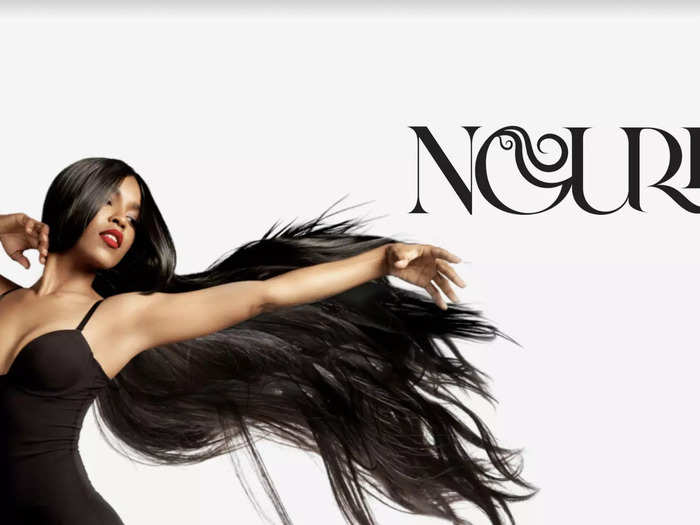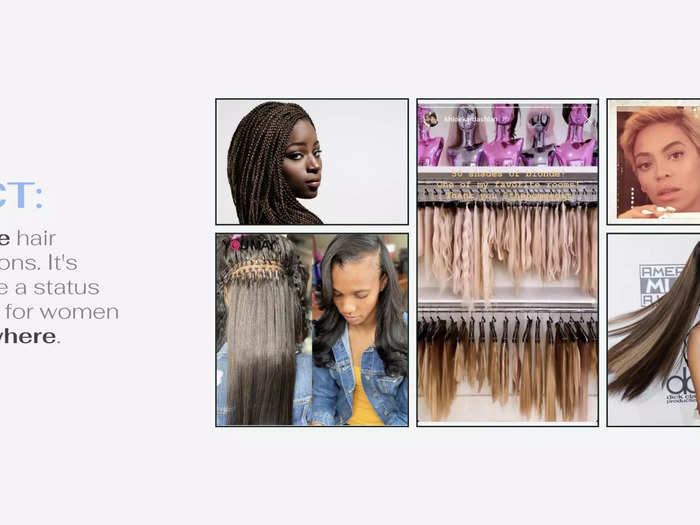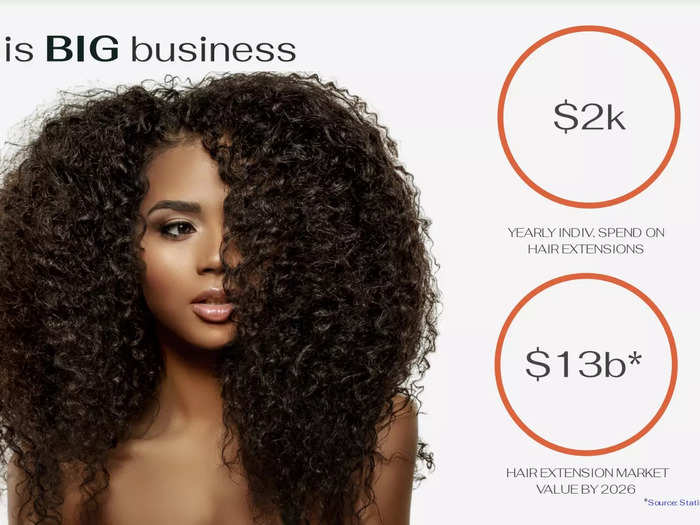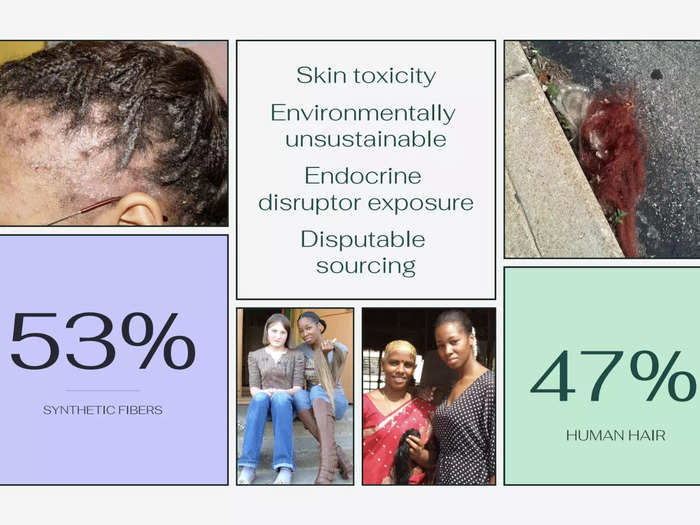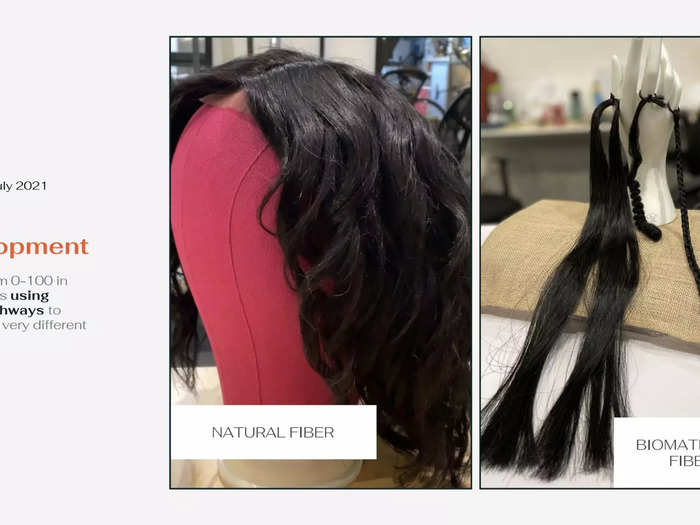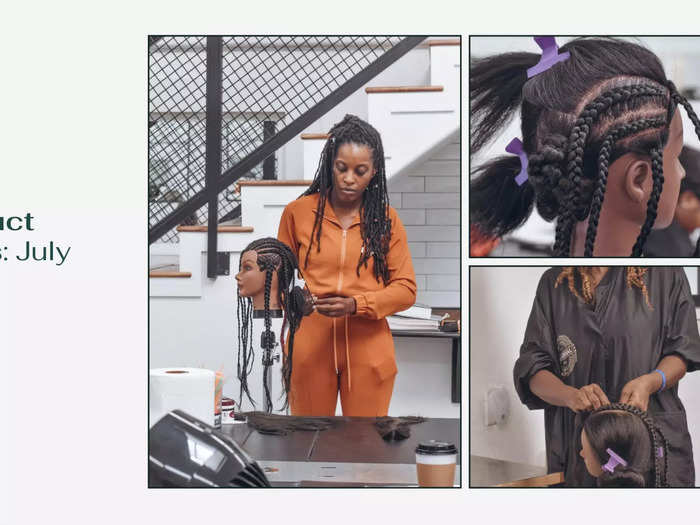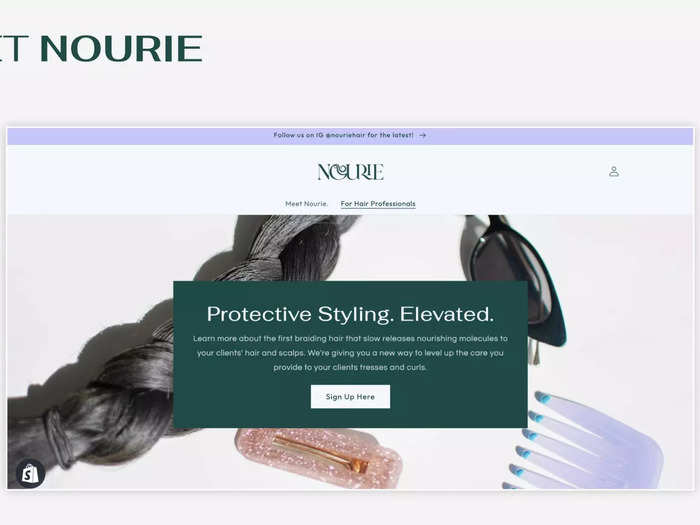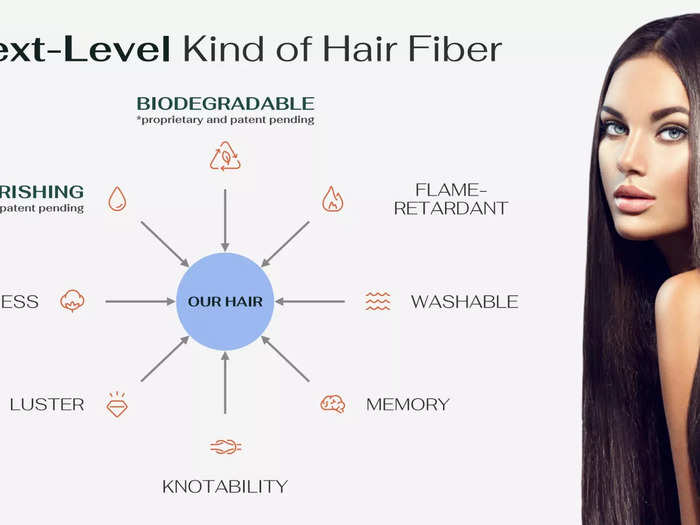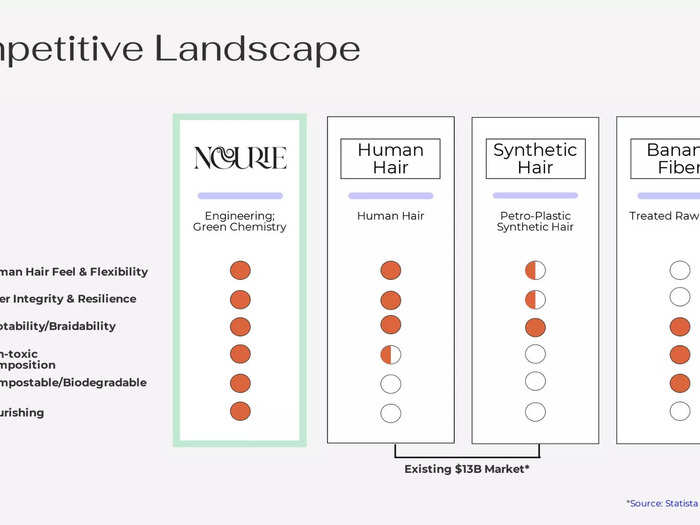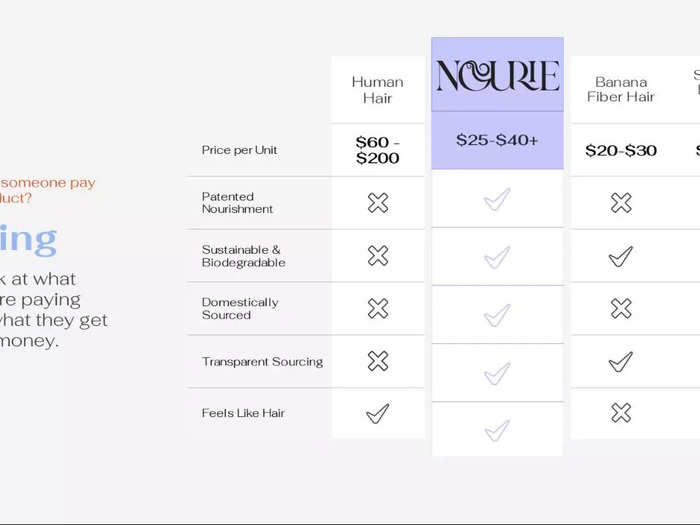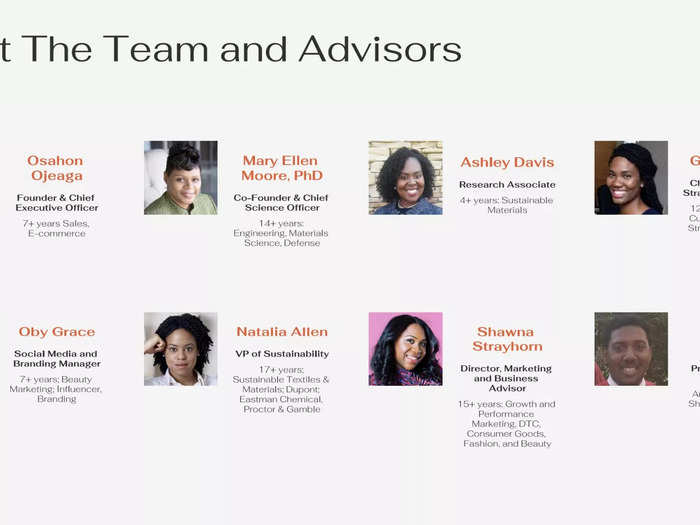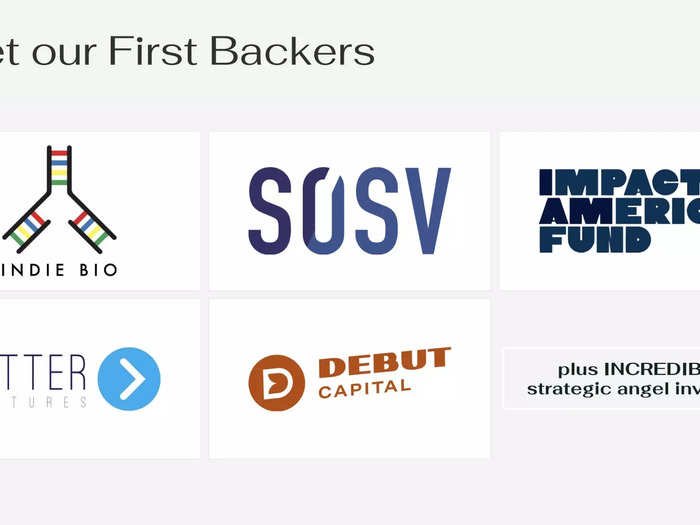Osahon Ojeaga, right, and her cofounder Mary Ellen Moore.courtesy of Ojeaga
- Osahon Ojeaga is the cofounder of Nourie, a startup that soon plans to begin selling plant-based braiding hair extensions
- Nourie closed a $2.5 million seed round in September, a difficult feat for Black female founders.
Osahon Ojeaga started her career in Silicon Valley, working for startups in fintech and software as a service. But after four years of being one of the few Black women in the room, and constantly fighting to be seen, she was burned out.
Ojeaga went on a trip to Southeast Asia to rediscover herself and redefine what her career meant to her. Knowing that she probably wouldn't have access to hair-care products or oils while traveling, she got her hair braided ahead of her trip in a protective style, which keeps the ends tucked away to prevent breakage. However, she had a negative experience with the specific protective style, she said. That bad braiding experience left her frustrated by the limited options Black women had to protect their hair.
"It was my first time having a bad experience after being exposed to Silicon Valley and the way that problems get solved," said Ojeaga, adding that she felt emboldened to create a solution.
In 2020, she came up with the concept of Nourie, a startup that makes plant-based braiding hair extensions that deliver nutrients to the scalp. Ojeaga and her cofounder Mary Ellen Moore joined forces in late 2020, and after two years of product development and testing, the founders expect Nourie products to be available in November.
In September, Nourie closed a $2.5 million seed round to fund her brand's launch, led by Impact America Fund, Better Ventures, and SOSV's accelerator IndieBio, a difficult feat for many Black female founders. In fact, as of 2021, fewer than 200 Black women had ever raised more than $1 million in venture capital. Ojeaga shared her pitch deck and advice, especially as global capital investments have shrunk this year and the rates of investments into Black-owned businesses remain low.
Here's her 14-page pitch deck and advice for generating funding as a Black woman in America.
Nourie's introduction slide set the scene for the pitch.
The Nourie pitch deck's introduction slide. courtesy of Ojeaga
The pitch deck begins with an image that highlights what Nourie does and stands for, Ojeaga said. The dramatic hair, beautiful Black woman, and bold logo act as an introduction to the type of company Nourie hopes to be, she added.
"We use this image to really show what we can do," she said.
Then, the deck explains the prevalence of hair extensions.
The deck explains the prevalence of hair extensions. courtesy of Ojeaga
The next slide includes photos of hair extensions, wigs, and braids to show investors how important hair is in today's society, Ojeaga said. For instance, Ariana Grande's iconic ponytail, Khloé Kardashian's wig closet, and Beyoncé's short wig show the star power behind hair.
"I used this slide to show that it is a status symbol for a lot of women," Ojeaga said. "It's not just Black women, people from all demographics and economic statuses are participating in this space."
Along with these photos, Ojeaga also asks investors how familiar they are with hair extensions. Depending on their answers, she will decide how in-depth to explain the concept. Either way, she said, she tries not to spend too much time explaining it before getting to the next slide.
"It's the dollars that attract investors," she said.
The deck explains the market value of the hair industry. courtesy of Ojeaga
The next slide focuses on two stats: the amount of money women who use hair extensions might spend each year and the projected value of the hair-extension market.
"It's the dollars that attract investors, and I try to go into the significance of these dollars," Ojeaga said.
What's more, she'd compare these figures to topics investors tend to be more familiar with, such as annual car payments or iPhone prices.
The deck tells investors about the current issues customers face.
The deck tells investors about the current issues. courtesy of Ojeaga
Then, Ojeaga explains the problem her company is trying to solve by showing investors images of current issues surrounding hair extensions, such as scalp toxicity, piles of plastic waste, and unethical human hair sourcing.
These images reflect problems such as the damage unsafe braiding can have on the health of a scalp along with the negative environmental impacts of single-use plastic and synthetic hair.
Then she explains the brand's stance on sustainability.
The deck explains the brand's stance on sustainability. courtesy of Ojeaga
After explaining the health and environmental detriments of the hair-extension industry in its current form, Ojeaga introduces the brand's stance on sustainability.
"Sustainability is a word that is thrown around and, for the longest time, hasn't been taken seriously," Ojeaga said. "What I really want to emphasize here is that we're making something that's legitimately sustainable."
To support her sustainability claims, she explains the company's production process.
The development process is shown to investors.
Then she shows the development process to investors. courtesy of Ojeaga
Up next, she shows photos of the development process alongside information about the company's production timeline. After conceptualizing Nourie, Ojeaga and Moore participated in an accelerator program and developed two prototypes in four months.
"Investors want to see speed," she said. "They want to know that your team is able to move fast."
Additionally, she uses this slide to show investors her and Moore's ability to take multiple approaches and quickly decide which one to pursue. She said many investors viewed this skill as an asset in entrepreneurs.
Next, images of the prototype and product trials are displayed.
Next, the prototype is displayed. courtesy of Ojeaga
The next slide shows professionals testing out the Nourie extensions.
The deck also shows product trials. courtesy of Ojeaga
It was important for Ojeaga to include various images of the final prototypes to show numerous ways hair can be worn, styled, and seen, she said.
"This page showcases different textures, fiber diameters, and colors," she added.
It's important for her to emphasize this variety to prove that, when the product goes to market, it will be accessible for women with various hairstyle preferences, she said.
The direct-to-consumer website is displayed.
The future direct-to-consumer website is shown. courtesy of Ojeaga
Though the products aren't yet available to consumers, Ojeaga includes an example of how the website will look to give investors a glimpse into what the company imagines the customer experience to look like.
Then, she establishes Nourie's place in the market.
The deck establishes Nourie's place in the market. courtesy of Ojeaga
The graphic on this slide starts differentiating Nourie from other hair-extension brands by highlighting what the product offers customers.
"Investors want to know what's really difficult about what you're doing," Ojeaga said. "I use this slide to show it's hard to get a product that has all of these properties in it."
Setting the competitive scene.
The chart shows how the brand compares to current competition. courtesy of Ojeaga
When investors see this slide, Ojeaga addresses any questions they have about specific competitors, as well as the larger hair-extension landscape.
"I usually don't spend too much time on this slide, but there's always this question of 'Who's your competition?'" she said. "The competition is this $13 billion market that already exists."
This slide compares Nourie against current market pricing.
This slide compares Nourie against current market pricing. courtesy of Ojeaga
The next slide compares Nourie with other types of extensions, such as human hair, synthetic, and banana fiber. The chart explains the average cost for each of the varieties and what they offer customers.
"When describing the value of our product compared to the value of what exists in the market today, you can't beat it," Ojeaga said, adding that it's important to make this clear to investors.
She said she'd tell investors she wanted her product "to leave your scalp in a better state than when you install it" and that "nothing else here is going to do that." This point further differentiates Nourie from existing brands that investors might see as competition, she said.
The Nourie team is highlighted next.
The Nourie team. courtesy of Ojeaga
This slide shows the Nourie team and advisors, which makes clear that this is an all-Black, predominantly female team, Ojeaga said. Showcasing the team also highlights Ojeaga's mission of inclusion along with her support for Black communities and Black beauty.
"This is a group of people who have had careers in the past and have experienced trauma because of their gender and because of what they look like," she said, adding that she's proud of her ability to bring this team together to create something all members are passionate about.
Finally, she shares the company's first supporters.
The brand's first financial supporters are displayed. courtesy of Ojeaga
The presentation ends with a list of Nourie's financial supporters and investors, which allows investors to feel confident in their decision to fund Nourie, Ojeaga said. Each time a new deal was made in the fundraising process, the logo would be added to this list for potential investors to see, she added. This version of the pitch includes the investors from Nourie's latest fundraising round.
"The purpose of this slide is to prove legitimacy in the space that you are in," Ojeaga said. "It also creates a little bit of FOMO," she added, using the acronym for "fear of missing out."
She said it was important to credit those who'd helped the brand get to where it was while also conveying excitement and urgency for the new investors.

